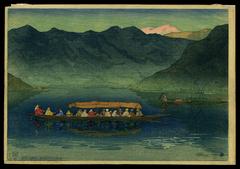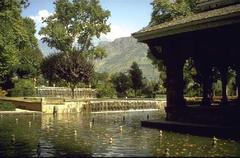Visiting Hours and Tickets for Khanqah-E-Moula in Budgam
Date: 17/08/2024
Introduction
The Khanqah-e-Moula, also known as the Khanqah of Shah-i-Hamadan, stands as a distinguished religious and historical monument in Srinagar, Kashmir. Revered for its spiritual significance and architectural splendor, the site attracts thousands of pilgrims and tourists alike. Constructed in 1395 by Sultan Sikander to honor the Sufi saint Mir Sayyid Ali Hamadani, the Khanqah-e-Moula has long been a beacon of spiritual transformation in the Kashmir Valley (The Kashmiriyat). The shrine’s architectural style is a unique blend of Islamic, Buddhist, and Hindu influences, featuring intricate woodwork and multi-tiered roofs that reflect the syncretic ethos of Kashmir (The Kashmiriyat). This guide aims to provide comprehensive information for those planning to visit Khanqah-e-Moula, covering its rich history, architectural marvels, visitor tips, and nearby attractions.
Table of Contents
- Introduction
- Historical Background
- Visitor Information: Tickets, Hours, and Accessibility
- Travel Tips for Visiting Khanqah-e-Moula
- Nearby Attractions in Srinagar
- Controversies and Debates
- Modern-Day Relevance
- Visitor Experience
- FAQ
- Conclusion
Historical Background
Origins and Early History
Constructed in 1395 by Sultan Sikander in honor of the revered Sufi saint Mir Sayyid Ali Hamadani, also known as Shah-i-Hamadan, the Khanqah-e-Moula marks a pivotal point in the spiritual and cultural transformation of the Kashmir Valley. Shah-i-Hamadan, originally from Hamadan in Iran, played a crucial role in spreading Islam in the region (The Kashmiriyat).
Architectural Significance
The Khanqah-e-Moula is celebrated for its unique architectural style, blending Islamic, Buddhist, and Hindu influences. Primarily constructed from wood, it features intricate carvings and detailed craftsmanship that reflect Kashmir’s syncretic ethos. Key architectural elements include multi-tiered roofs, wooden balconies, and ornate eaves (The Kashmiriyat).
Spiritual and Cultural Impact
More than just a mosque, the Khanqah-e-Moula serves as a center for Sufi teachings and practices. The rituals and prayers held here are deeply rooted in Shah-i-Hamadan’s spiritual legacy. Historically, the site has welcomed devotees from various faiths, including Muslims, Hindus, and Sikhs, making it a beacon of religious harmony and coexistence (The Kashmiriyat).
Resilience Through Adversity
Despite facing numerous challenges such as fires, political upheavals, and changes in regimes, the Khanqah-e-Moula has endured. This resilience is due to the efforts of various rulers and the unwavering devotion of its followers. Significant contributions to its reconstruction were made by Sultan Sikander, Mir Muhammad Hamadani, and the Mughal emperor Aurangzeb. Even during the Sikh and British eras, the Khanqah maintained its sanctity (The Kashmiriyat).
Visitor Information: Tickets, Hours, and Accessibility
For those planning to visit Khanqah-e-Moula, here are some essential details:
- Visiting Hours: The mosque is open to visitors from 6 AM to 8 PM daily.
- Tickets: Entry to Khanqah-e-Moula is free of charge.
- Accessibility: The site is accessible to visitors of all ages, although the wooden structure includes steps that may require assistance for those with mobility issues.
Travel Tips for Visiting Khanqah-e-Moula
- Best Time to Visit: The best time to visit Srinagar and Khanqah-e-Moula is during the spring (March to early May) and autumn (September to November) when the weather is pleasant.
- What to Wear: Modest attire is recommended out of respect for the site’s religious significance.
- Local Etiquette: Visitors are encouraged to respect the sanctity of the mosque and participate in rituals if interested.
Nearby Attractions in Srinagar
While in Srinagar, consider visiting these nearby attractions:
- Dal Lake: Famous for its houseboats and Shikara rides.
- Shankaracharya Temple: A historic Hindu temple offering panoramic views of the city.
- Mughal Gardens: Beautifully designed gardens like Shalimar Bagh and Nishat Bagh.
- Jama Masjid: Another historic mosque located in the old city of Srinagar.
Controversies and Debates
The origins of the Khanqah-e-Moula have sparked debates among historians and scholars. Some traditional Kashmiri Hindu historians do not mention a pre-existing temple, while other narratives suggest the site was initially a Hindu temple dedicated to the goddess Kali. This claim is supported by certain elements at the site considered sacred by Kashmiri Hindus (The Kashmiriyat).
Modern-Day Relevance
Today, Khanqah-e-Moula remains a vital part of Kashmir’s cultural and spiritual landscape. It continues to attract devotees and tourists seeking spiritual solace and a glimpse into Kashmir’s rich history (The Kashmiriyat).
Visitor Experience
The serene environment of Khanqah-e-Moula offers a space for reflection and contemplation. Visitors are encouraged to respect the site’s sanctity and explore the surrounding areas, including the nearby River Jhelum, to enhance their overall experience (Wanderlog).
FAQ
- What are the visiting hours of Khanqah-e-Moula? The mosque is open from 6 AM to 8 PM daily.
- How much are the tickets to Khanqah-e-Moula? Entry is free of charge.
- What are the best times to visit Khanqah-e-Moula? The best times to visit are during spring and autumn.
Conclusion
Khanqah-e-Moula remains a vital part of Kashmir’s cultural and spiritual landscape, resonating with centuries of history, architectural grandeur, and religious significance. Despite numerous challenges, including fires and political upheavals, the shrine has endured, thanks to the unwavering devotion of its followers and the efforts of various rulers (The Kashmiriyat). Today, it continues to serve as a center for Sufi teachings and a symbol of religious harmony. Visitors can immerse themselves in its serene ambiance, explore its intricate architectural details, and gain a deeper understanding of Kashmir’s rich history. Whether you’re a devotee seeking spiritual solace or a tourist eager to explore historical sites, Khanqah-e-Moula offers a unique and enriching experience. For more travel tips and updates, be sure to download our mobile app Audiala and follow us on social media.
References
- The Kashmiriyat. Khanqah-e-Moula: A Spiritual Phoenix that Survived Fires & Kashmir’s Historical Trials. Retrieved from The Kashmiriyat
- Indian Holiday. Khanqah-E-Moula. Retrieved from Indian Holiday
- Explore Our India. Khanqah-e-Moula, Srinagar. Retrieved from Explore Our India
- Brighter Kashmir. Khanqah-e-Moula: A Beacon of Faith & Heritage in Srinagar. Retrieved from Brighter Kashmir
- Wanderlog. Khanqah-e-Moula. Retrieved from Wanderlog
- Travel Setu. Khanqah of Shah Hamdan Tourism. Retrieved from Travel Setu


